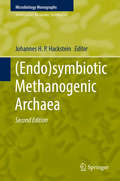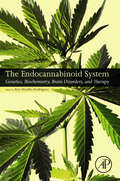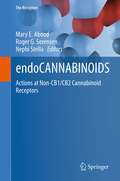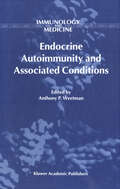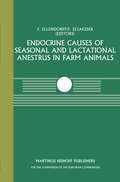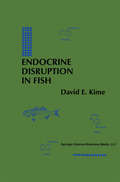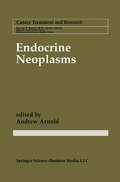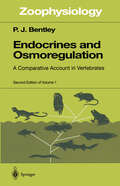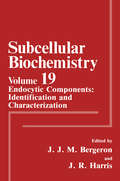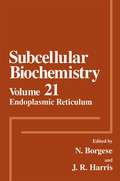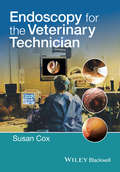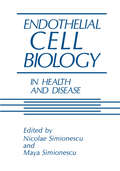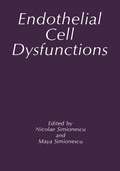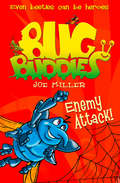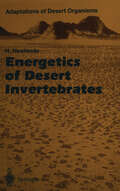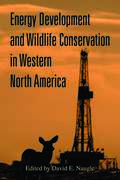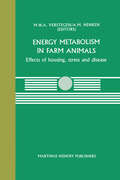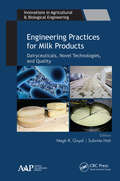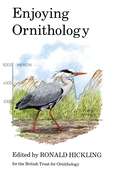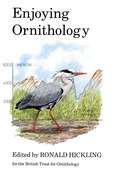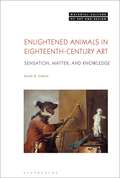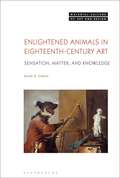- Table View
- List View
(Endo)symbiotic Methanogenic Archaea
by Johannes H. HacksteinThis updated monograph deals with methanogenic endosymbionts of anaerobic protists, in particular ciliates and termite flagellates, and with methanogens in the gastrointestinal tracts of vertebrates and arthropods. Further chapters discuss the genomic consequences of living together in symbiotic associations, the role of methanogens in syntrophic degradation, and the function and evolution of hydrogenosomes, hydrogen-producing organelles of certain anaerobic protists. Methanogens are prokaryotic microorganisms that produce methane as an end-product of a complex biochemical pathway. They are strictly anaerobic archaea and occupy a wide variety of anoxic environments. Methanogens also thrive in the cytoplasm of anaerobic unicellular eukaryotes and in the gastrointestinal tracts of animals and humans. The symbiotic methanogens in the gastrointestinal tracts of ruminants and other “methanogenic” mammals contribute significantly to the global methane budget; especially the rumen hosts an impressive diversity of methanogens. This makes this updated volume an interesting read for scientists and students in Microbiology and Physiology.
The Endocannabinoid System: Genetics, Biochemistry, Brain Disorders, and Therapy
by Eric Murillo-RodriguezThe Endocannabinoid System: Genetics, Biochemistry, Brain Disorders, and Therapy examines the cellular, biochemical, genetic, and therapeutic aspects of the endocannabinoid system. The chapters cover significant conceptual advances in the endocannabinoid field and shed light on the many brain disorders in which this biological system is involved. Written by world-leading experts in the field, the topics covered in this book will have a positive impact on the area of molecular biology, including, but not limited to, cell biology, neuroscience, pharmacology, signaling, disease mechanisms, and therapeutics.Provides an introduction to endocannabinoids in the central nervous system and an overview to their functions in the brainPresents information on neurobiological and cellular studies on the role of the cannabinoid signaling system and its implications in human diseasesIncludes well-written overviews of the basics of endocannabinoid system structure and function Contains well-illustrated material, with diagrams, charts, and tablesExplores compelling case studies and their application to chapters written by experts
endoCANNABINOIDS: Actions at Non-CB1/CB2 Cannabinoid Receptors (The Receptors #24)
by Mary E. Abood, Roger G Sorensen and Nephi StellaThis book is intended as a scientific resource for cannabinoid researchers carrying out animal and human experiments, and for those who are interested in learning about future directions in cannabinoid research. Additionally, this book may be of value to investigators currently working outside the field of cannabinoid research who have an interest in learning about these compounds and their atypical cannabinoid signalling. This book provides insight into the potential medical application of cannabinoids and their therapeutic development for the treatment of human disease.
Endocrine Autoimmunity and Associated Conditions (Immunology and Medicine #27)
by A. P. WeetmanAutoimmunity is the most common cause of endocrine disorders. This volume provides an up-to-date summary of recent advances in this important field. In addition, it describes developments in our understanding of conditions such as vitiligo and pernicious anaemia which are frequently associated with autoimmune endocrinopathies. There is a detailed review of animal models of endocrine disease which have contributed greatly to current knowledge. Furthermore, the aetiology, pathogenesis and treatment of the clinical disorders are discussed in depth. The book will be of interest to anyone working in the areas of endocrinology and immunology.
Endocrine Causes of Seasonal and Lactational Anestrus in Farm Animals: A Seminar in the CEC Programme of Co-ordination of Research on Livestock Productivity and Management, held at the Institut für Tierzücht und Tierverhalten, Mariensee, Bundesforschumgsanstalt für Landwirtschaft (FAL) October 2–3, 1984 (Current Topics in Veterinary Medicine #31)
by F. Elsaesser F. EllendorffEndocrine Disruption in Fish
by David E. KimeThe last half-century has shown a dramatic increase in the standard of living of millions of people in Europe, North America and many parts of the Third World. This has, in many ways been brought about by scientific and technical developments which were initiated in the 1940s and 1950s. Promises were then made that nuclear energy would provide electricity so cheap that it would not need metering, pesticides would end malnutrition throughout the world and plastics and other synthetic chemicals would revolutionise our manufacturing industry and our way of life. Whilst some of these promises have been fulfilled, the problems of long-term health risks to humans and wildlife arising from the use, production and disposal of these products were either unknown or deliberately understated. Nuclear power is rendered economically unviable when the real cost of decommissioning and storage of waste for several millenia is included, and the effects on health of both humans and wildlife of early pest eradication programmes with organochlorine pesticides were well documented in Rachel Carson's "Silent Spring". Evidence of the effects of aerosols and refrigerants on depletion of the ozone layer has led to restriction on the use of CFCs, and there is now increasing evidence of climate change resulting from our profligate use of fossil fuels.
Endocrine Neoplasms (Cancer Treatment and Research #89)
by AndrewArnoldAndrew Arnold The past several years have been a time of intense excitement and have brought major advances in the understanding and treatment of endocrine neoplasms. This is therefore an excellent point at which to undertake a broad based overview of the state of the art in endocrine neoplasia for the Cancer Treatment and Research series. Because of the wide and interdisciplinary readership of this series, our aim for each chapter has been to provide ample background for those not highly familiar with the topic, while emphasizing the most recent advances. Furthermore, the chapters have been written with the clinician in mind, whether she or he is an oncologist, endocrinologist, surgeon, generalist, pathologist, or radiologist. As such, the authors' mission has been to focus on clinically relevant issues and to present the scientific basis of current or potential future advances in a manner easily digestible to the nonexpert. Endocrine tumors often cause problems for the patient by virtue of their hormonal activity, which may frequently (but certainly not always) over shadow the adverse consequences related to their mass per se. In fact, it is important to keep in mind that endocrine tumors can manifest two biologically separable but often intertwined properties, namely, increased cell mass and abnormal hormonal function. These need not go hand in hand, and their distinction has definite clinical relevance in, for example, the increasingly recognized problem of incidentally discovered adrenal or pituitary masses.
Endocrines and Osmoregulation: A Comparative Account in Vertebrates (Zoophysiology #39)
by P.J. BentleyFrom a review of the previous edition: "I strongly recommend it as an essential reading and reference book for younger and older workers alike". Nature
Endoscopy for the Veterinary Technician
by Susan CoxEndoscopy for the Veterinary Technician is a comprehensive resource for the proper care and handling of endoscopes and accompanying instrumentation for a variety of procedures. An inclusive reference on the proper care and handling of endoscopes and instrumentation Provides step-by-step details on a variety of endoscopic procedures, highlighting patient preparation, needed equipment, anesthesia, post-procedure care, and complications Offers numerous color images to help identify equipment and provide a visual guide to procedures Includes specific technician tips throughout the text
Endoscopy for the Veterinary Technician
by Susan CoxEndoscopy for the Veterinary Technician is a comprehensive resource for the proper care and handling of endoscopes and accompanying instrumentation for a variety of procedures. An inclusive reference on the proper care and handling of endoscopes and instrumentation Provides step-by-step details on a variety of endoscopic procedures, highlighting patient preparation, needed equipment, anesthesia, post-procedure care, and complications Offers numerous color images to help identify equipment and provide a visual guide to procedures Includes specific technician tips throughout the text
Endothelial Cell Biology in Health and Disease
by M. Simionescu N. SimionescuAlthough blood capillaries were first observed through a flea-lens microscope by Malpighi in 1661,200 more years elapsed before the cellular nature of the vessel wall was conclusively demonstrated. Beginning with the middle of the 19th cen tury, our knowledge of the histological organization of blood vessels has steadily increased. However, the endothelium, which for a long time was considered to be just an inert barrier lining, had been barely explored until three decades ago. Since then, there has been an upsurge of interest in the fine structure and function of endothelial cells. Intense in vivo and in vitro investigations have revealed that the endothelial cell is a key element in a wide variety of normal activities and diseases. A large number of investigators and laboratories have been attracted to endothelial cell research, thus supporting the expansion of the continuously grow ing and diversifying field of endotheliology. The number of articles published annually on this subject has increased from a few score at the beginning of the 1970s to more than a thousand in recent years, and an increasing number of journals, books, societies, and symposia focused primarily on the vascular en dothelium have marked the last decade.
Endothelial Cell Dysfunctions
by M. Simionescu N. SimionescuNoted experts survey and evaluate the latest research in the growing field of endothelial cell involvement in the initiation and development of various diseases. Research-oriented chapters span a diversity of topics, including endothelial cell response to various injuries and its crucial role in inflammation, immunity, viral infection, hypertension, hyperlipidemia, atherosclerosis, diabetes mellitus, neoplasia, and metastasis.
Enemy Attack! (Bug Buddies #2)
by Joe MillerEven bugs can be heroes! Join the Bug Buddies on bug-tastic adventures, as they pit their wits against the dreaded spider Spinner, creepiest of all creepy crawlies…
Energetics of Desert Invertebrates (Adaptations of Desert Organisms)
by Harold HeatwoleDesert invertebrates live in an environment where resources alternate unpredictably between brief periods of plenty and prolonged scarcity. This book describes the adaptive strategies of desert invertebrates in acquiring energy and sustaining life with such fluctuations. Some cooperate in foraging; others compete for resources. Some are nomadic and migrate to more favorable sites as conditions change. Others conserve energy by going into a deep dormancy until better conditions return. Still others store food during plentiful periods so as to retreat underground during less favorable times. The adaptive modes of economizing on scarce energy resources are diverse and lead to an appreciation of the intricate interactions of animals living close to their environmental limits.
Energy Development and Wildlife Conservation in Western North America
by David E. NaugleEnergy Development and Wildlife Conservation in Western North America offers a road map for securing our energy future while safeguarding our wildlife heritage. Contributors show how science can help craft solutions to conflicts between wildlife and energy development by delineating core areas, identifying landscapes that support viable populations, and forecasting future development scenarios to aid in conservation design.The book calls for a shift away from site-level management that has failed to mitigate cumulative impacts on wildlife populations toward broad-scale planning and implementation of conservation in priority landscapes. It concludes by identifying ways that decision makers can remove roadblocks to conservation, and provides a blueprint for implementing conservation plans.
Energy Metabolism in Farm Animals: Effects of housing, stress and disease (Current Topics in Veterinary Medicine #44)
by M. W. A. Verstegen and A. M. HenkenAnimal production systems have changed dramatically over the last two decades. Knowledge of energy metabolism and environmental physio logy has increased as appears from many textbooks on these disciplines. The contents of the symposia on energy metabolism of farm animals show this and they have initially focussed on feed evaluation and later on com parative aspects of energy metabolism. They show part of the progress being made. Application of knowledge of energy metabolism for animals has a long history since Lavoisier. In addition to this, studies about the environ mental requirements of animals have shown that we are still far from ac curate assessment of these requirements in terms of nutrients and ener gy. I n model studies on energy metabolism researchers have recognized the interaction between the environment and the energy requirements of animals. Estimation of energy requirements has been done in physiolo gical, physical and behavioural studies. The impact of conditions as en countered by animals in various production systems has been approached from different viewpoints related to these different disciplines. In addi tion, various kinds of infections (bacterial, parasitic: subclinical, clini cal) have been evaluated only recently with regard to their effect on pro tein and/or energy metabolism and thus on production. People working in the field of feed evaluation have defined how che mical and physical properties of nutrition infiuence energy to be derived for maintenance and production.
Engineering for Cats: Better the Life of Your Pet with10 Cat-Approved Projects
by Mac DelaneyLearn how to construct a fancy cat water fountain, cat shelves, and more, in this whimsical but practical guide. Aerospace engineer Mac Delaney leads readers through 10 projects that solve everyday cat-people problems, complete with step-by-step illustrations.
Engineering Practices for Milk Products: Dairyceuticals, Novel Technologies, and Quality (Innovations in Agricultural & Biological Engineering)
by Megh R. Goyal Subrota HatiWhile also addressing the need for more effective processing technologies for increased safety and quantity, the dairy industry needs to address the growing customer demand for new and innovative dairy foods with enhanced nutritional value. This volume looks at new research, technology, and applications in the engineering of milk products, specifically covering functional bioactivities to add value while increasing the quality and safety of milk and fermented milk products. Chapters in the book look at the functional properties of milk proteins and cheese, functional fermented milk-based beverages, biofunctional yoghurt, antibiotic resistant pathogens, and other probiotics in dairy food products.
Engineering Practices for Milk Products: Dairyceuticals, Novel Technologies, and Quality (Innovations in Agricultural & Biological Engineering)
by Megh R. Goyal Subrota HatiWhile also addressing the need for more effective processing technologies for increased safety and quantity, the dairy industry needs to address the growing customer demand for new and innovative dairy foods with enhanced nutritional value. This volume looks at new research, technology, and applications in the engineering of milk products, specifically covering functional bioactivities to add value while increasing the quality and safety of milk and fermented milk products. Chapters in the book look at the functional properties of milk proteins and cheese, functional fermented milk-based beverages, biofunctional yoghurt, antibiotic resistant pathogens, and other probiotics in dairy food products.
Enjoying Ornithology (Poyser Monographs)
by Ronald HicklingThis year, 1983, the British Trust for Ornithology celebrates its first 50 years and this volume records much of the history of birdwatching and ornithology since the early 1930s. The book is not a history of the BTO, but many of the Trust's achievements helped fashion the development and direction of ornithology over the decades, and major aspects of the Trust's work rightly have detailed treatment. The book ranges widely, it looks at the changing bird as well as the changing bird watcher and records the work of related conservation bodies, it considers the future and the past and includes an extensive section of useful facts and figures, whilst never losing sight of the central theme which is the book's title.
Enjoying Ornithology (Poyser Monographs #109)
by Ronald HicklingThis year, 1983, the British Trust for Ornithology celebrates its first 50 years and this volume records much of the history of birdwatching and ornithology since the early 1930s. The book is not a history of the BTO, but many of the Trust's achievements helped fashion the development and direction of ornithology over the decades, and major aspects of the Trust's work rightly have detailed treatment. The book ranges widely, it looks at the changing bird as well as the changing bird watcher and records the work of related conservation bodies, it considers the future and the past and includes an extensive section of useful facts and figures, whilst never losing sight of the central theme which is the book's title.
Enlightened Animals in Eighteenth-Century Art: Sensation, Matter, and Knowledge (Material Culture of Art and Design)
by Sarah CohenHow do our senses help us to understand the world? This question, which preoccupied Enlightenment thinkers, also emerged as a key theme in depictions of animals in eighteenth-century art. This book examines the ways in which painters such as Chardin, as well as sculptors, porcelain modelers, and other decorative designers portrayed animals as sensing subjects who physically confirmed the value of material experience.The sensual style known today as the Rococo encouraged the proliferation of animals as exemplars of empirical inquiry, ranging from the popular subject of the monkey artist to the alchemical wonders of the life-sized porcelain animals created for the Saxon court. Examining writings on sensory knowledge by La Mettrie, Condillac, Diderot and other philosophers side by side with depictions of the animal in art, Cohen argues that artists promoted the animal as a sensory subject while also validating the material basis of their own professional practice.
Enlightened Animals in Eighteenth-Century Art: Sensation, Matter, and Knowledge (Material Culture of Art and Design)
by Sarah CohenHow do our senses help us to understand the world? This question, which preoccupied Enlightenment thinkers, also emerged as a key theme in depictions of animals in eighteenth-century art. This book examines the ways in which painters such as Chardin, as well as sculptors, porcelain modelers, and other decorative designers portrayed animals as sensing subjects who physically confirmed the value of material experience.The sensual style known today as the Rococo encouraged the proliferation of animals as exemplars of empirical inquiry, ranging from the popular subject of the monkey artist to the alchemical wonders of the life-sized porcelain animals created for the Saxon court. Examining writings on sensory knowledge by La Mettrie, Condillac, Diderot and other philosophers side by side with depictions of the animal in art, Cohen argues that artists promoted the animal as a sensory subject while also validating the material basis of their own professional practice.
